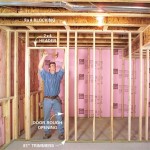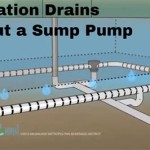Basement Watchdog Pump Was Activated: Check Main for Failure to Register
A sump pump is a critical component of a home's drainage system, designed to prevent flooding and water damage, particularly in basements. The Basement Watchdog is a popular brand of sump pump, known for its reliability and effectiveness. However, a common issue homeowners encounter is the Basement Watchdog pump activating, but the main pump failing to register the activation. This discrepancy can lead to a variety of problems, ranging from a delayed response to rising water levels to a complete failure to prevent flooding. Examining the causes and troubleshooting steps for this issue is crucial for maintaining a dry and safe basement.
When the Basement Watchdog pump activates, it signifies that water is accumulating in the sump pit at a rate exceeding the capacity of the primary pump. This could be due to heavy rainfall, a high water table, or a malfunction of the primary pump itself. In such situations, the Basement Watchdog serves as a backup, ensuring that the water is removed before it reaches a level that could cause damage. However, if the main pump fails to acknowledge this activation, several scenarios could be at play. These scenarios necessitate a thorough investigation to identify the root cause and implement the necessary corrective actions.
Understanding the interplay between the primary pump and the Basement Watchdog is essential. The primary pump operates under normal conditions, handling the routine drainage of water that seeps into the sump pit. The Basement Watchdog, on the other hand, is designed to activate only when the primary pump is unable to keep up or fails entirely. This redundancy provides an added layer of protection against flooding. The failure of the primary pump to register the Basement Watchdog's activation disrupts this redundancy, creating a vulnerability that must be addressed promptly.
Understanding the Functional Mechanism of Both Pumps
The primary sump pump and the Basement Watchdog operate on similar principles but with different activation mechanisms and priorities. The primary pump typically uses a float switch or pressure sensor to detect water levels in the sump pit. When the water reaches a predetermined level, the switch activates the pump, which then discharges the water through a pipe leading away from the house. The Basement Watchdog, being a backup system, often employs a separate float switch or sensor that triggers when the water level rises even higher, indicating that the primary pump is failing or overwhelmed.
The communication, or lack thereof, between the two pumps is critical. Ideally, the activation of the Basement Watchdog should serve as an alert to the homeowner that the primary pump is not functioning correctly. However, there isn't usually direct communication between the pumps in terms of electrical signaling. The homeowner observes the situation and infers a problem with the main pump based on observing the backup running. Therefore, understanding how the primary pump detects water levels and initiates pumping is vital for troubleshooting.
If the primary pump's float switch is stuck or damaged, it may not activate even when water levels are high. Similarly, a clogged or damaged impeller within the pump can prevent it from effectively removing water. Electrical issues, such as a tripped circuit breaker or a faulty power cord, can also render the primary pump inoperable. These factors can all contribute to the Basement Watchdog activating without the primary pump showing any signs of activity. A detailed inspection of each component of the primary pump is necessary to pinpoint the source of the problem.
Diagnosing the Reasons for the Malfunction
Pinpointing the reason why the Basement Watchdog is activated while the main pump remains inactive requires a systematic approach. First, the homeowner must visually inspect the primary pump. This inspection should include checking for any visible obstructions in the sump pit, such as debris or sediment that could be interfering with the float switch. The float switch itself should be manually tested to ensure that it moves freely and activates the pump when raised. If the float switch is stuck or sluggish, it may need to be cleaned or replaced.
Next, the electrical components of the primary pump should be examined. The circuit breaker that powers the pump should be checked to ensure that it has not tripped. If the breaker is tripped, it should be reset. However, if the breaker trips repeatedly, it may indicate a more serious electrical problem that requires the attention of a qualified electrician. The power cord and plug should also be inspected for any signs of damage or wear. A faulty power cord can prevent the pump from receiving power, even if the circuit breaker is functioning correctly.
The impeller, the rotating component that moves water through the pump, should be checked for clogs or damage. Debris such as small stones, leaves, or sediment can become lodged in the impeller, preventing it from rotating properly. If the impeller is clogged, it can be carefully cleaned using a small brush or tool. If the impeller is damaged, it may need to be replaced. Finally, the discharge pipe should be inspected for any obstructions or kinks that could be restricting the flow of water. A blocked discharge pipe can cause the pump to work harder and eventually fail. A comprehensive examination of these elements will usually uncover why the primary pump wasn't working when the backup was needed.
Troubleshooting and Corrective Actions
Once the cause of the malfunction has been identified, appropriate corrective actions can be taken. If the float switch is the problem, cleaning or replacing it is usually a straightforward process. Most float switches can be easily removed and replaced with a new one. If the impeller is clogged, carefully removing the debris and ensuring that the impeller rotates freely can restore the pump's functionality. If the discharge pipe is blocked, clearing the obstruction or replacing the pipe can resolve the issue.
If the problem is electrical, the first step is to ensure that the circuit breaker is functioning correctly. If the breaker trips repeatedly, it may be necessary to have an electrician inspect the wiring to identify any underlying electrical problems. Replacing a damaged power cord or plug can also restore power to the pump. However, if the pump itself is faulty, it may need to be replaced. Sump pumps have a limited lifespan, and eventually, they will wear out and need to be replaced.
In cases where the primary pump is old or inefficient, upgrading to a newer, more powerful model can be a worthwhile investment. Newer sump pumps often feature improved designs, more efficient motors, and longer lifespans. They may also include features such as built-in alarms that alert the homeowner to potential problems. Regularly testing both the primary pump and the Basement Watchdog is crucial for ensuring that they are functioning correctly. This can be done by manually filling the sump pit with water and observing whether the pumps activate and effectively remove the water. Consistent maintenance and prompt repairs are vital for preventing future problems and protecting the basement from water damage. Regular inspections of the sump pit, float switches, and discharge pipes are also essential for identifying and addressing potential issues before they escalate.
In conclusion, the activation of the Basement Watchdog pump while the primary pump fails to register highlights a critical issue that requires immediate attention. By understanding the functional mechanisms of both pumps, diagnosing the reasons for the malfunction, and implementing appropriate corrective actions, homeowners can ensure the continued effectiveness of their basement flood protection system. Regular maintenance, prompt repairs, and periodic testing are key to preventing future problems and maintaining a dry and safe basement.

Economical Backup Solution Basement Watchdog
Economical Backup Solution Basement Watchdog
Emergency Instruction Qxd

Basement Watchdog Bwd12 120c Bwd12120c Big Dog Connect Backup Sump Pump 2200 Gph 10

Glentronics Basement Watchdog Emergency Battery Backup Plumbing Pump System

Basement Watchdog Bwsp Special Connect Backup Sump Pump 1850 Gph 10

Have A Question About Basement Watchdog Emergency Battery Backup Sump Pump System Pg 5 The Home

Basement Watchdog Bwd12 120c Bwd12120c Big Dog Connect Backup Sump Pump 2200 Gph 10

Reviews For Basement Watchdog Big Combo Connect 1 2 Hp Primary And Battery Backup Sump Pump System With Smart Wi Fi Capable Monitoring Controller Pg The Home

Basement Watchdog Bw4000 Connect 1 2 Hp Combination Primary Backup Sump Pump System
Related Posts







